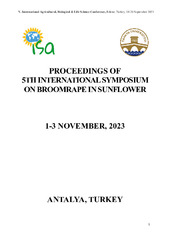Приказ основних података о документу
Climate-responsive approaches for building durable resistance of sunflower to broomrape in evolving environmental conditions
| dc.creator | Cvejić, Sandra | |
| dc.creator | Jocić, Siniša | |
| dc.creator | Jocković, Milan | |
| dc.creator | Dedić, Boško | |
| dc.creator | Radanović, Aleksandra | |
| dc.creator | Ćuk, Nemanja | |
| dc.creator | Miklič, Vladimir | |
| dc.creator | Miladinović, Dragana | |
| dc.date.accessioned | 2023-11-21T12:05:28Z | |
| dc.date.available | 2023-11-21T12:05:28Z | |
| dc.date.issued | 2023 | |
| dc.identifier.isbn | 978-625-00-1676-3 | |
| dc.identifier.uri | http://fiver.ifvcns.rs/handle/123456789/4022 | |
| dc.description.abstract | The presence of various biotypes of broomrape (Orobanche cumana Wallr.), each differing in their virulence towards sunflower (Helianthus annuus L.), has been widely documented. Highly virulent races of broomrape (F, G and H) have been observed in numerous sunflower cultivation regions. It is important to note that biotypes of O. cumana belonging to the same race can exhibit varying levels of virulence; for instance, race F from Spain may differ significantly from race F in Romania. In light of these variations, conducting systematic multi-environmental testing on available germplasm becomes crucial for identifying stable genetic sources of resistance. The IFVCNS has organized multi-environmental testing to evaluate its breeding material, identifying several resistance genes. Some resistance sources are governed by major genes, while others follow recessive inheritance or exhibit quantitative trait loci (QTL) resistance. Managing broomrape in sunflower production poses challenges due to the parasite's ability to adapt and overcome existing resistance mechanisms. Climate change is considered as a potential factor behind the rapid changes in the racial composition of the parasite. Although resistance to O. cumana is frequently breached, utilizing multiple resistance sources is crucial in combating the emergence of new races. While resistance based on a single gene can be easily transferred to elite breeding material and prove effective in the short term, achieving durable resistance necessitates the combination of different resistance genes from diverse sources, including both quantitative and qualitative modes of resistance. Consequently, the incorporation of multiple resistance genes into a single genotype has demonstrated improved resistance durability. Moreover, it is essential to ensure that these genes do not have adverse effects on other desired traits. By capitalizing on the strengths of durable resistance approach, the breeding team at IFVCNS has successfully developed sunflower hybrids with enhanced broomrape resistance and increased sustainability. These advances contribute to sunflower production systems' long-term success and stability, ultimately mitigating the challenges posed by broomrape and changing climatic conditions. | sr |
| dc.language.iso | en | sr |
| dc.publisher | Edirne : Trakya University | sr |
| dc.relation | info:eu-repo/grantAgreement/MESTD/inst-2020/200032/RS// | sr |
| dc.relation | info:eu-repo/grantAgreement/EC/HE/101059784/EU// | sr |
| dc.relation | info:eu-repo/grantAgreement/ScienceFundRS/Ideje/7732457/RS// | sr |
| dc.relation | Climate Crops - Centre of Excellence for Innovations in Breeding of Climate-Resilient Crops, Institute of Field and Vegetable Crops | |
| dc.rights | openAccess | sr |
| dc.rights.uri | https://creativecommons.org/licenses/by/4.0/ | |
| dc.source | Proceedings, 5th International Symposium on broomrape in sunflower, 1-3 November 2023, Antalya | sr |
| dc.subject | sunflower | sr |
| dc.subject | broomrape | sr |
| dc.subject | races | sr |
| dc.subject | genes | sr |
| dc.subject | resistant hybrids | sr |
| dc.subject | durability | sr |
| dc.title | Climate-responsive approaches for building durable resistance of sunflower to broomrape in evolving environmental conditions | sr |
| dc.type | conferenceObject | sr |
| dc.rights.license | BY | sr |
| dc.citation.epage | 17 | |
| dc.citation.spage | 16 | |
| dc.identifier.fulltext | http://fiver.ifvcns.rs/bitstream/id/9781/bitstream_9781.pdf | |
| dc.identifier.rcub | https://hdl.handle.net/21.15107/rcub_fiver_4022 | |
| dc.type.version | publishedVersion | sr |


